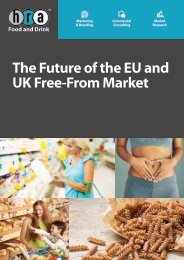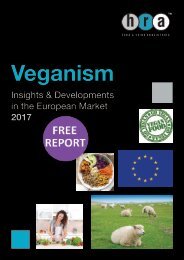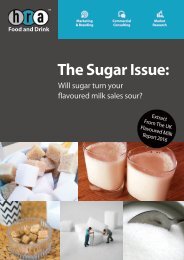Flavoured_Milk_Free
The backdrop to the UK flavoured milk market is one of relentless change. The removal of the EU milk quotas, the transition by emerging economies to a Western-style diet, the upcoming introduction of the ‘sugar tax’ and the booming sports nutrition industry are all aspects of change that create both challenges and opportunities for the UK flavoured milk market. HRA Food and Drink has developed this report as a map to guide industry stakeholders. Although volume growth in 2014 was slightly lower than in previous years, the flavoured milk market still has plenty of room for product innovation in the future.
The backdrop to the UK flavoured milk market is one of relentless change. The removal of the EU milk quotas, the transition by emerging economies to a Western-style diet, the upcoming introduction of the ‘sugar tax’ and the booming sports nutrition industry are all aspects of change that create both challenges and opportunities for the UK flavoured milk market.
HRA Food and Drink has developed this report as a map to guide industry stakeholders. Although volume growth in 2014 was slightly lower than in previous years, the flavoured milk market still has plenty of room for product innovation in the future.
Create successful ePaper yourself
Turn your PDF publications into a flip-book with our unique Google optimized e-Paper software.
UK FLAVOURED MILK MARKET 2017 & BEYOND<br />
To view please<br />
purchase full report<br />
Figure 8.21: EU 28 milk production in million litres, 2012-2015 (Dairy Co)<br />
Total increase in production was forecasted at 1% for 2015/16. Since the quotas were<br />
removed, production levels have been higher than forecasted (see figure 8.21).<br />
Subsequently, milk prices have declined, reaching levels not observed since 2009 due to<br />
oversupply.<br />
EU production has generally been increasing year-on-year. This, combined with several<br />
factors that include the 2014 Russian embargo on agricultural imports and subdued<br />
demand from China, has led to a decline in global demand and thus, on incomes for EU<br />
farmers.<br />
As the global population and incomes continues to grow, and demand for dairy rises, the<br />
long-term prospects for dairy production remains positive. As seen in figure 8.22, EU<br />
exports of dairy products are generally increasing. This is despite the Russian embargo in<br />
2014 which restricted exports and in doing so helped the EU establish and grow trade<br />
relationships with other countries.<br />
152<br />
© 2016 Teepee Limited. All Rights Reserved.







